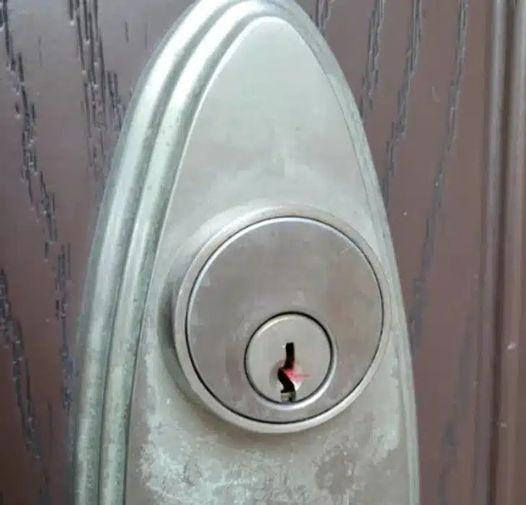This morning, while locking up, I noticed something unusual: red wax in my front door’s keyhole. I know for sure it wasn’t from my keys, yet there was red wax on the tip when I pulled my key out. Now, I can’t help but feel uneasy. Did someone tamper with my lock? What could this mean?

A Possible Explanation: A Squatter or Burglar’s Tactic
Finding red wax in your keyhole might seem strange, but it could be a serious red flag. According to security experts, this tactic is sometimes used by squatters or burglars to identify houses that are currently occupied or empty. It’s a subtle way for them to test a home’s activity without drawing much attention.
How Does This Work?
The process is surprisingly simple. An intruder places red wax or another marker in the keyhole. If someone uses the key and removes the wax, it’s a clear sign that the house is occupied. If the wax stays untouched for a period of time, it signals to the intruder that the house might be vacant, making it a potential target.
This strategy allows criminals to gather information without having to break in, lowering their risk of being caught. It’s essentially a low-risk reconnaissance method for those intending to burglarize or squat in a seemingly abandoned home.
Why You Should Take This Seriously
If you find red wax or any other unusual substance in your door lock, it’s critical not to dismiss it. It could indicate that someone has been scoping out your home, possibly with plans to break in or squat. In such situations, it’s always better to err on the side of caution to ensure the safety of your property and loved ones.
What To Do If You Find Wax in Your Lock
- Document the Evidence: Take clear photos of the wax in the keyhole for documentation. These could be useful if you need to file a report with law enforcement.
- Notify the Police: Even if everything else seems fine, let local law enforcement know about the discovery. They might increase patrols in the neighborhood or keep an eye out for suspicious behavior.
- Improve Your Security: Consider upgrading your home security. This could mean installing a video doorbell, adding motion-activated lighting, or reinforcing your locks. Making your home harder to access can discourage potential intruders.
- Alert Your Neighbors: If someone is targeting your home, they could be targeting others nearby as well. Informing your neighbors can help everyone stay aware and vigilant.
Recognizing Other Signs of Targeting
While red wax is one potential indicator of criminal intent, there are other tactics that intruders may use to mark or test homes. Here are some additional signs to watch out for:
- Tape on Door Locks: Small pieces of tape or stickers placed over keyholes or door seams can be used to see if they are disturbed.
- Chalk Marks on Walls or Mailboxes: Chalk marks can indicate that a house has been identified as an easy target.
- Unusual Objects Left Near Your Door: Items like bottles, rocks, or other objects left near entryways could be markers to observe if they are moved.
Prevention Is Key
When it comes to protecting your home, prevention is the best strategy. The goal is to make your home appear occupied at all times, as burglars tend to target homes that seem vacant. Here are some effective ways to enhance your home’s security:
- Install Timed Lighting: Use timers for interior lights when you’re away to make it appear as though someone is home.
- Keep Entryways Well-Lit: Bright, motion-activated lights can deter criminals from approaching your home at night.
- Use Smart Cameras and Doorbells: These devices not only provide evidence if someone attempts a break-in but also serve as visual deterrents.
- Maintain Your Yard: Regularly trimmed hedges and clear entryways prevent intruders from finding cover around your home.
Conclusion: Take Action If You Notice Something Odd
Finding red wax in your keyhole is not just a quirky discovery—it could be a sign of something more sinister. It may indicate that someone is attempting to gauge your home’s occupancy status, which is often a precursor to burglary. By staying alert, contacting law enforcement, and implementing preventive measures, you can help protect your home and family from potential threats. Always trust your instincts—if something feels off, it’s better to act promptly than to ignore potential warning signs.





